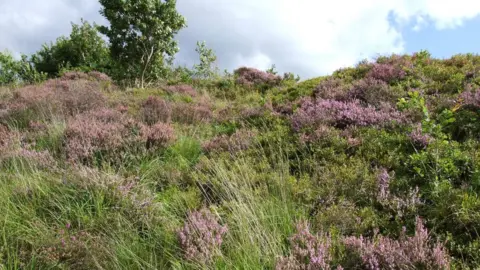Restoring peatlands to 'reduce risk of wildfires' in south Wales
Restoring peatlands in an area blighted by wildfires could help reduce the risk of blazes starting, conservationists say.
It is hoped a project aiming to "rewet" former bogs in the south Wales valleys would also help wildlife to thrive and reduce greenhouse gasses.
The landscape in the area changed after commercial forestry led to the planting of conifer trees in the 1950s.
Many peat bogs have also been drained for farming.
The team behind the Lost Peatlands of South Wales project is developing plans to restore over 540 hectares (1,334 acres) of historic landscape and habitat in Neath Port Talbot and Rhondda Cynon Taff.
They would create peat bogs and pools, heathland, grassland and native woodland.
"We want to restore this fantastic landscape, that's been hidden by forestry for years... to what it was previously," ecologist Rebecca Sharp said.
"Forest fires is a real problem in this area, rewetting this landscape will reduce the ability of fires to take hold."
 Rhian Grundy
Rhian GrundyIn 2018, South Wales Fire and Rescue Service, were called to 1,956 wildfires.
In the eight year period from 2010-2018, the fire service dealt with 18,625 wildfires, of which, 17,487 were started deliberate.
Craig Hope, station manager at the fire service, said: "Landscapes have changed because of a lack of grazing but with rewetting, we can protect peat.
"Rewetting areas will change the plant types to ones less likely to burn. Breaking up the vegetation is something we welcome."
Peatlands are re-wetted in a variety of ways including the construction of small dams being dug into trenches in the ground to capture water that would otherwise run off.
This, coupled with management of trees in the area will, ecologists hope, encourage the peat to regenerate across the area.
 NPTC
NPTCCouncillor Annette Wingrave, from Neath Port Talbot council, said she hoped the plans would "benefit both of our local areas, and the people living and working here".
Councillor Ann Crimmings, from Rhondda Cynon Taf council, added: "This fantastic and innovative project will restore a substantial amount of the historic landscape to the top of the valleys, not only providing residents with access to new outdoor recreation spaces, but also encouraging various species of wildlife to flourish."
The National Lottery Heritage Fund has awarded the project £260,000 for plans to be developed further.
